Looking for something to direct her energy into after her children had left home, Catherine Hicks dug deep into her psyche and realised there was a stifled artist inside just waiting to get out.
Having pushed away the urge to create art for many years, a weekend painting course led to a year of concentrated painting and a need to take her work a step further. She fed her cravings through studying art history and learning about her favourite artists. She began experimenting with paint, dye and woven ribbon strips, piecing together larger works of art.
One day, she started to panic during a class assignment. She had to create a self-portrait with pastels but couldn’t work with them. She made a snap decision to try using pastel-colour thread for the portrait instead. It was a great success and a journey into the world of fibre art beckoned. Now, several years on and Catherine is a professional embroidery artist. Her prize-winning portraits have been shown internationally and throughout the United States.
She freely admits that she is capable of making only three stitches, straight stitch, French knots, and buttonhole. With these three stitches, she gives her portraits a great detail with a lively depth through her expert understanding of light and shadow.
She has spent time investigating how to use thread as an alternative medium to paint. And with a keen interest in the history of art she has used her embroidery to discover artists from the past, as well as exploring feminism. In her recent work Catherine has been creating portraits on sheer fabrics mounted on mirrors to delve into our habits of inward and outward gazing in a world obsessed with visual imagery.
Catherine has focussed on portraits for the last four years and in 2019 she showed her work at the Microcosm Group Show at the Modern Eden Gallery (San Francisco) and at the Society for Embroidered Work’s Premiere Show at The Clerkenwell Gallery (London). She regularly takes part in the Art Hop Annual Show at Georgetown Library (Texas), and her solo exhibition “Through the Eye of her Needle; an Embellished Art History” was held at Woodlawn & Pope-Leighey House (Alexandria, Virginia) in 2019.
In this interview discover how Catherine jumped into the deep end, forcing herself to practice painting and write a blog about it and how after a year of sheer hard work, she’d begun to describe herself as an artist. She shares how she became intoxicated with creating portraits and gives us a great insight into the tips and tricks she uses in her embroidery portrait-making.
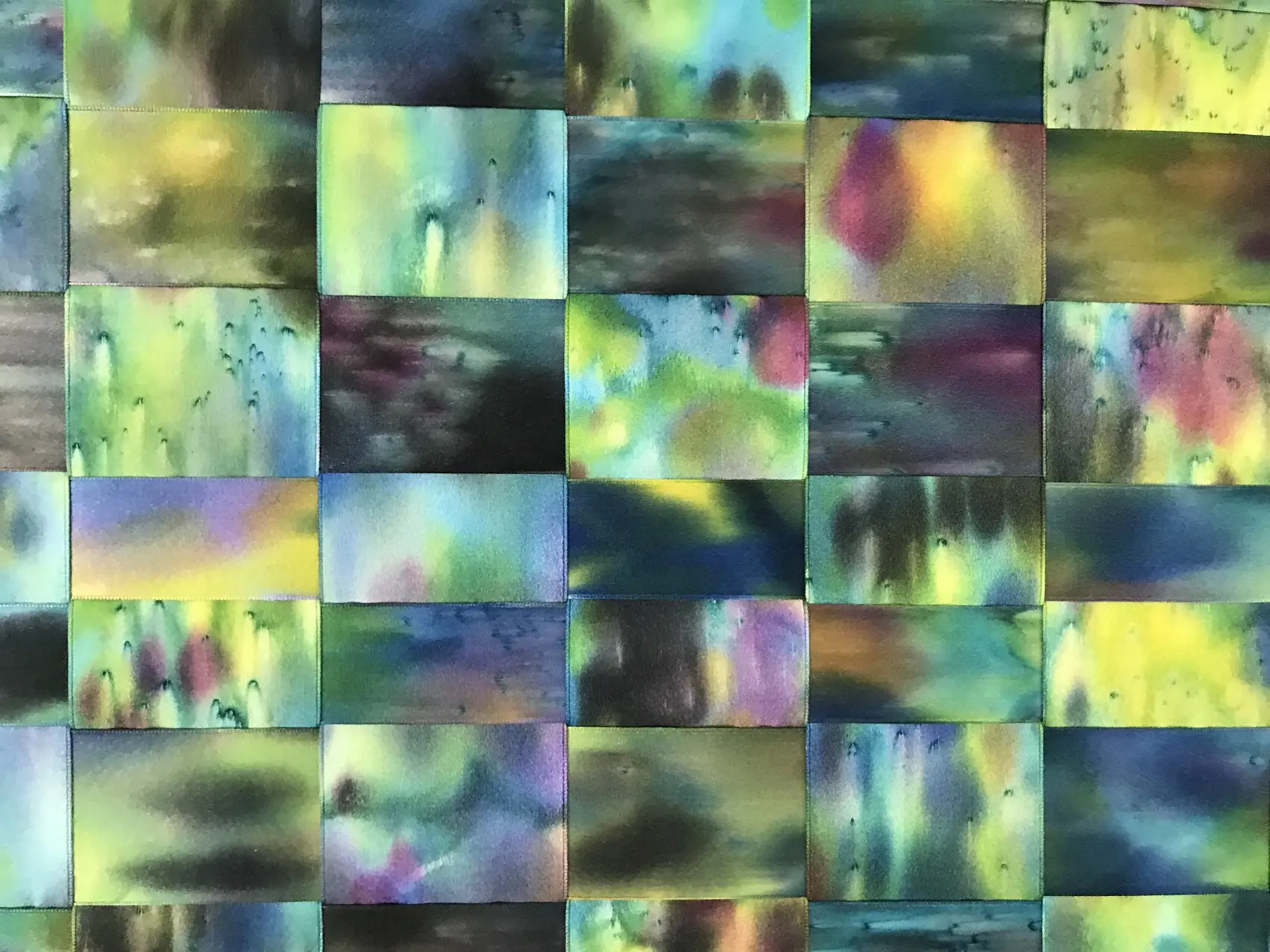
I scared myself into improving!
TextileArtist.org: What initially attracted you to textiles as a medium? How was your imagination captured?
Catherine Hicks: I didn’t choose textiles as a medium; textiles chose me! I was taught to knit, sew and stitch as a child and had engaged in these as hobbies throughout my adult life. But I had never considered what I was making as ‘Art’. Like many, I had been taught that Art (with a capital A) meant painting, sculpture, and architecture. I never dared to dream of becoming an artist because I didn’t know how to paint, and didn’t think that I had the time or the talent to learn!
Then fate intervened about nine years ago. My youngest son was graduating from High School and I looked inward to find a place to put all of the mothering energy that I’d made my top priority throughout my adult life.
At the time, my husband gave me a museum-based weekend painting course as a gift. Initially, I was petrified, particularly by the aspect of making something in front of others, but I got on with it and realized that what I was able to make wasn’t that bad. And it was actually a lot of fun! I learned a little about painting and a lot about the value of scaring myself. For me, that class was the door to a new path.
A few weeks later I woke up with the crazy idea to teach myself to paint and commit publicly by writing a blog about the experience. Another plan to scare myself into action!
Although friends thought I had lost my mind, I bought a biography of Vincent Van Gogh and gave myself a year to paint fifty paintings based on his work while publishing something about it all. I wanted it to be good but vowed to stick with it and be public about it even if it was terrible. The blog chronicled the struggle of learning to paint and how I taught myself the history of art. It was often difficult and embarrassing and in the eyes of many, it was a complete waste of time. But I stuck to my goal and during the process began referring to myself as an artist, something previously unthinkable.
At the end of the year, I came to another crossroads; should I continue, and how? I decided that my painting had improved enough and my interest level was still high enough so I looked for some formal art classes. I enrolled in my local community college and began taking Drawing, Design, and Art History courses. The assignments and deadlines kept my hands busy and my brain focussed on art-making.
But I was getting a little bored with painting, probably because I was too intimidated to try painting figures and all I felt I could do was make abstract work. After an intense study of Jackson Pollock, I wanted to try making drip paintings, but I had a problem: I live and work in a loft apartment that also houses my husband’s client-centered office. My studio is very small and I had no space to paint ‘big’.
Then I had the epiphany of breaking up my big painting into smaller pieces that could be woven together!
Without thinking or caring about what was high art and what was craft, I purchased yards of silk ribbons and dyes, then laid out the strips of ribbon on a thick layer of paper toweling, covering my 6-foot long kitchen counter with the stacked silk strips. A little music with a good beat and a lot of flung dye later, and I had a painting’s worth of colorful ribbons. I put these together into a three by five-foot textile piece by weaving the dyed ribbons onto thick stretcher bars padded with quilt batting.
That got me thinking that a painting could, in fact, be sewn. I could challenge the traditional definition of a painting. I started to sew all kinds of other abstract paintings using every material I could attach with thread. I made sequin paintings, ribbon paintings, bead paintings and paintings made with my sewing machine. A textile artist wasn’t yet born but was starting to consider her options.
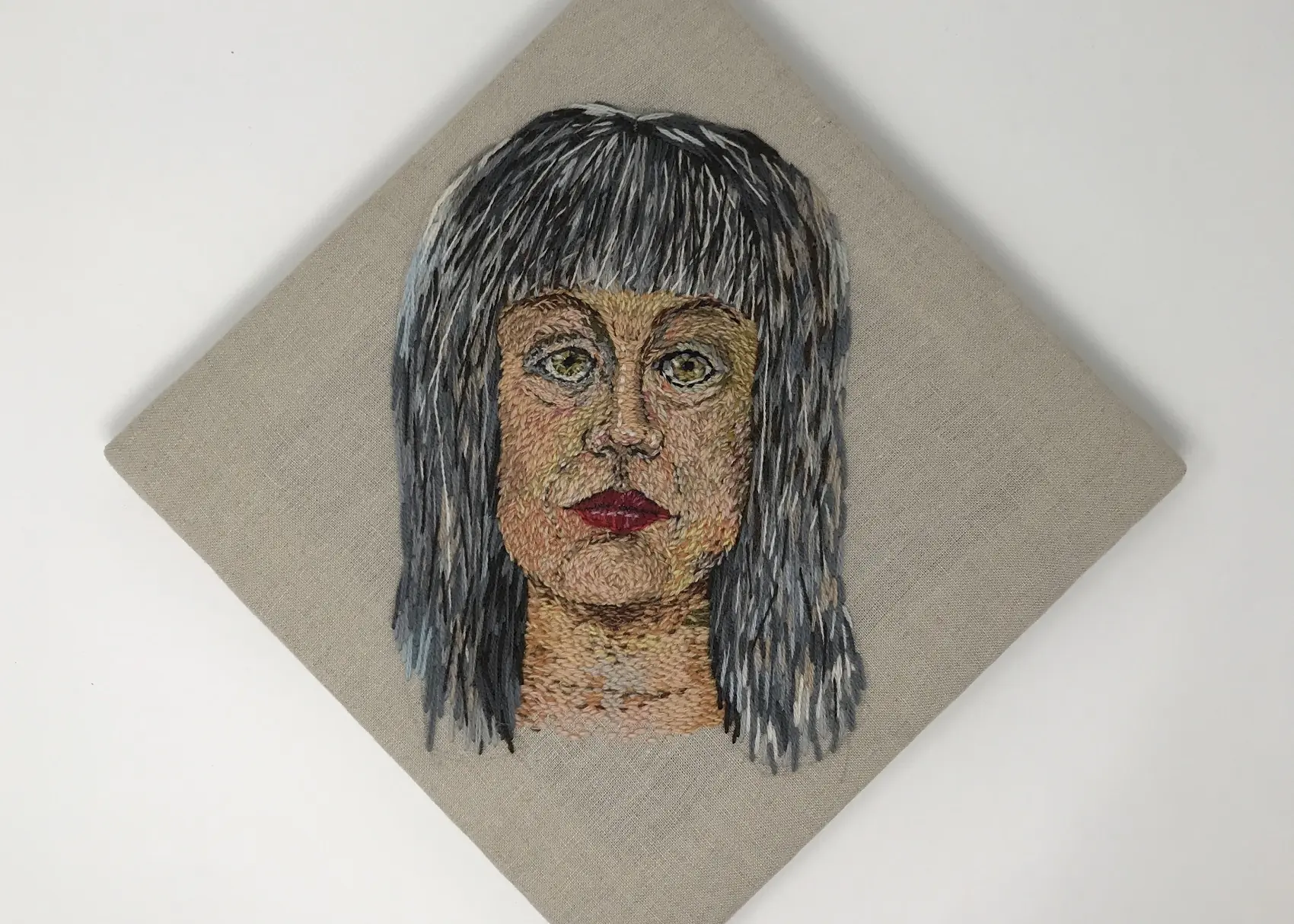
What or who were your early influences and how has your life/upbringing influenced your work?
After making enough fiber art abstracts to fill all of the walls in our loft, something kept nagging at me. I had the urge to paint a person. I felt that only by painting a beautiful portrait could I really consider myself to be a ‘true’ artist.
I’d made copies of several human portraits during my Vincent Project, by matching his work stroke by stroke until I was able to get a fair facsimile of his original painting. As I made those paintings, it felt a bit like I was cheating. I had to challenge myself to something more.
So I signed up for a Life Drawing Course at the community college. It was in that course, in a moment of homework deadline panic, that I learned to draw with thread.
I had been tasked with creating a self-portrait in pastel and found myself completely at odds with the smears and the dust. My utter inability to find precision with the crayons in my clumsy fingers was so frustrating. I knew it was time to take a break and I stood to leave the studio. My eyes fell on a basket of leftover needlepoint kit yarn. Washing the pastel dust from my hands I returned to the basket, chose some pink and yellow thread and thought to myself “Here’s some controllable pastel!”
I built a stretcher frame, covered it with some linen and drew a rudimentary face on it in pencil. Then I grabbed a sharp needle from my hand sewing kit and started sewing my first stitched portrait directly on my canvas.
A week and a half later, I hung my work for the class critical analysis session alongside all of the other student’s pastels. My teacher walked the line, pausing with shock when he came to mine. “How did you do that” he sputtered. He was intense and his expression was unreadable. Flashing crimson, I croaked out that I had sewed it with wool. He was incredulous. I told him how I had turned to embroidery after trying many times with the pastels. The other students gathered for a closer look, as the teacher awarded me an A grade for both the artwork and the entire course.
I figured that perhaps I was onto something. And I have been focussed on fiber art ever since.
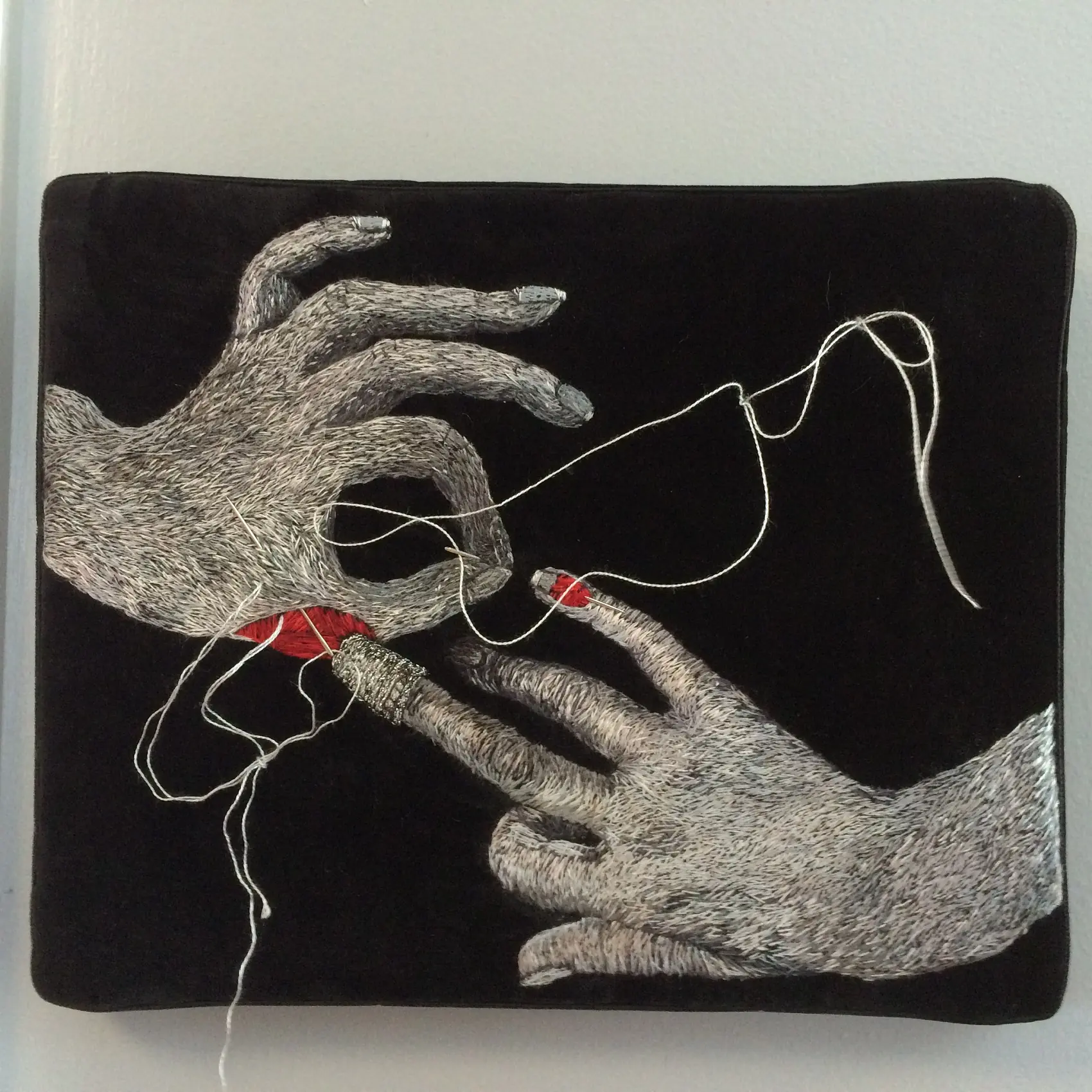
What was your route to becoming an artist?
My journey to becoming an artist started with my work on the Vincent Project, visits to every museum I could get to and the Art History courses I took. All of these became my first fiber art inspirations.
Initially, I would pick an artist whose work interested me, then do a study on their life and work. I would select a portrait photo or painting of the artist to embroider, then immerse myself in their life story as I stitched. YouTube made this very easy, with documentaries and snippets of film about many artists.
I stitched portraits of Frida Kahlo, Roy Lichtenstein, Salvador Dali, Suzanne Valadon, Alexander Calder, Georgia O’Keefe, and of course Vincent Van Gogh.
I also started making works based on other artists’ work, including a gold-work engagement portrait of my son and his fiancée based on Klimt’s “The Kiss,” a Texas twist on Lichtenstein’s “Drowning Girl,” and an MC Escher interpretation of Alfred Stieglitz’s iconic photograph of Georgia O’Keefe’s hands.
Using a Royal School of Needlework book, I taught myself to incorporate stump work when appropriate, for example by adding flowers to Frida’s hair or outfitting Vincent with a dimensional yellow straw hat brim, which in turn inspired a snarky moveable toupee on a portrait of Candidate Trump.
I kept on visiting museums and galleries. And I started looking at embroidery on Instagram, following a huge list of terrific artists including Cayce Zavaglia, Kate Kretz, Cat Frampton, Emily Tull, Claire Mort, Jenny Hart, Lucie Blair, Michelle Kingdom, Ipnot, Danielle Clough, Teresa Burrows, Georgina Bellamy, Elizabeth Griffiths, Jane Sanders, Lydia Needle, Linda Izan, Laura Schroeder, Jane C. Thom, Anna Liversidge, Kate Tume, Rachel Brown, Sarah Gwyer and others, many of whom are my fellow members of the Society for Embroidered Work (SEW).
Because I was making up my technique as I went along, I was very experimental in how I worked and the tools I used.
I prowled thrift stores, fine needlework shops and everything in between. I devoured embroidery blogs and magazines, just to see what equipment others were using by way of hoops, needles, and threads. I sought out internet resources like TextileArtist.org and Mr. X Stitch, learning everything I could about Contemporary Embroidery.
I learned to play with the supports for my embroidery, trying lots of different fabrics ranging from velvets, linens and light upholstery fabrics to sheer party dress textiles, and embroidering directly onto soluble interfacings.
I experimented with wire, then picked up beads, silk, wool, metallic items and anything I could trap by couching or get cleanly through the eye of a needle, including human hair.
In my year of painting, I built skills stroke by stroke. In my embroidery work, I knew that if I kept threading, stabbing and poking, eventually I would see the work in my head make its way onto my hoop.
I focussed obsessively on the process.
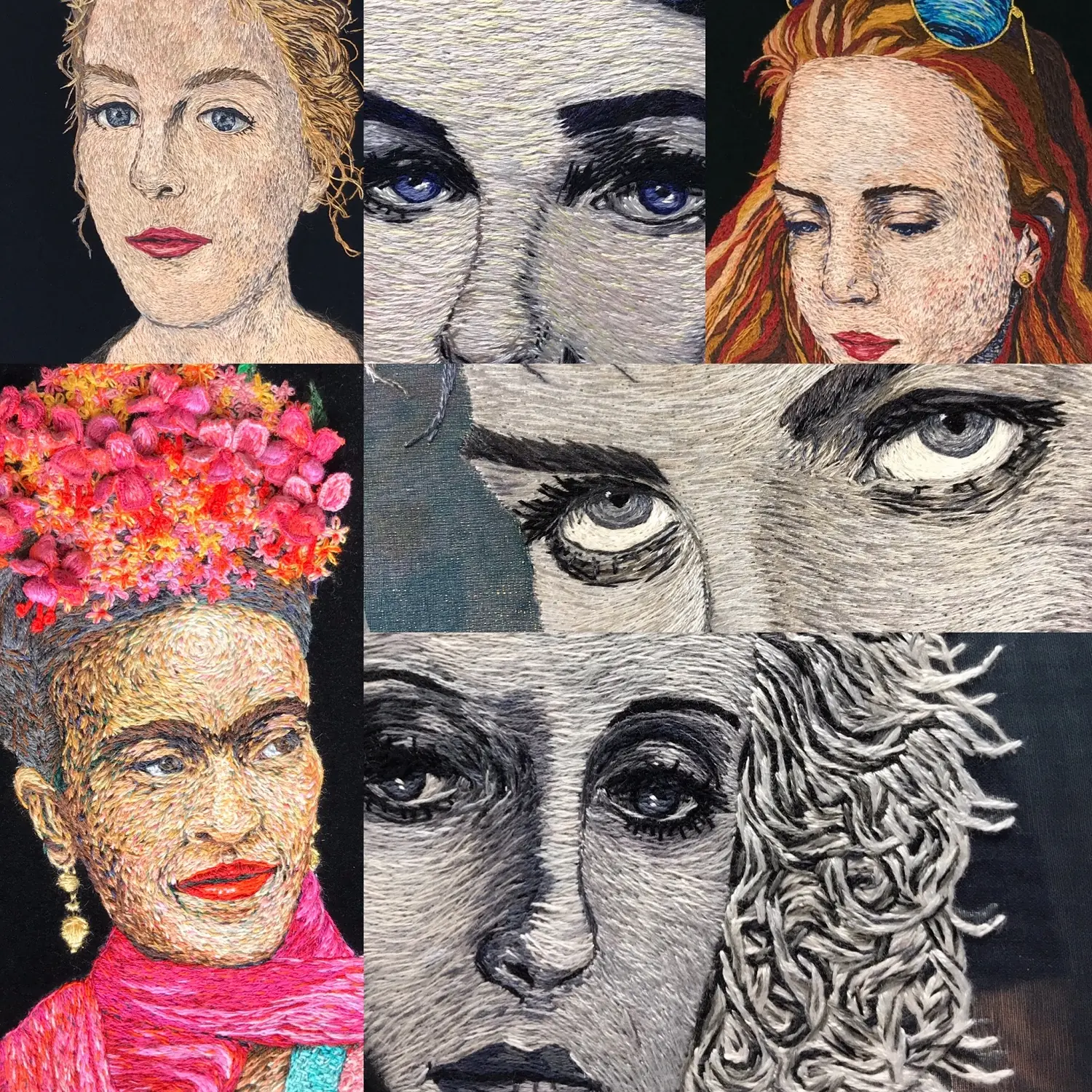
Art history inspires me
Tell us about your process from conception to creation
After finding my footing in fiber art, I began to ask myself questions that have come to define my work. What if paintbrushes had never been invented? What if pigment and oil had never been mixed? What if female creativity had ascended and men’s work had been dismissed as ‘craft’? How might art have been expressed, and who might have done the talking?
All of my work is wired and stitched from artistic memory, as an ongoing call and response between myself and artists of the past. Everything I make is a kind of memorial; a way of communing with the painters I wish I had known, rather than only learning of them from biographies and gallery walls.
Through my studies of art history, I have explored the lives and work of significant artists and reinterpreted their work through fiber art. Taking these ideas a step further, I am now trying to define the age and culture that I am living in by expanding my own definition of the “visual impact of cultural significance.”
With a provocative wink, my work has always aimed to explore art history and contemporary culture through traditionally feminine tools, such as needles, wire, and thread. With meditative stitches and hidden structure, I reimagine flat planes of shadow into visual images that leap dimensionally toward the viewer, with real depth and presence.
I am inspired by artists that create work in response to the tumult of their lives. When faced with physical and emotional obstacles they do not shrink but instead attack their problems with their paintbrushes, chisels, and needles. Like them I use my needle as a weapon, drawing it with the same passion and fight as Van Gogh, Kahlo, Rembrandt, Gentileschi and so many more.
My job as an Artist is to seriously ask myself every day “What, exactly, is interesting, right at this moment? What needs defending and good care? And what could use some gentle ribbing, or an outright smackdown? What am I seeing that I want others to notice?” My work is a response to these questions.
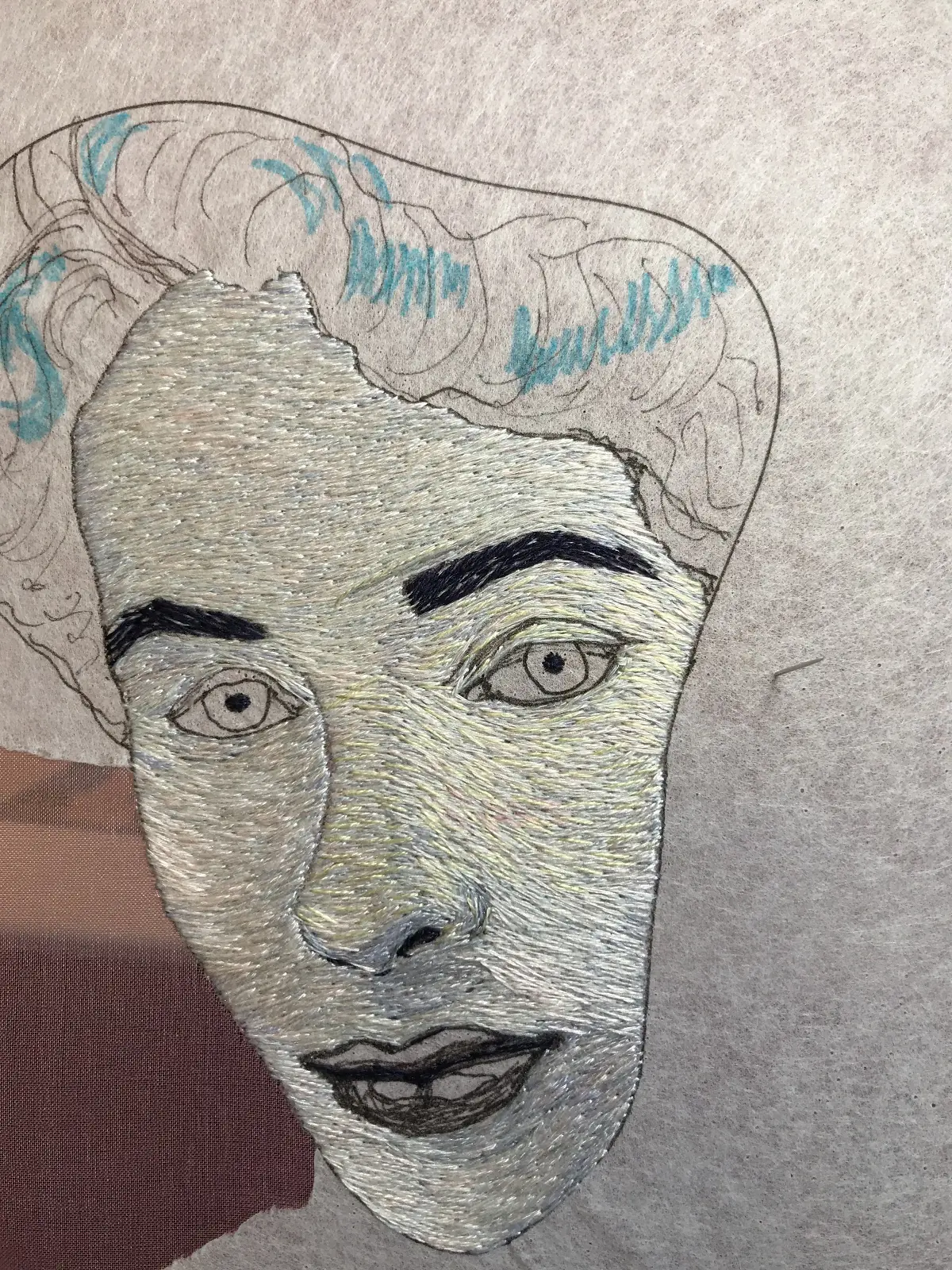
Tell us a bit about your chosen techniques and how you use them
I have focussed almost exclusively on embroidered portraits for the last four years. During that time I have tried many different ways of doing things. Sometimes it’s because I think that a different technique will lead to a better result. Other times it is because I can’t remember exactly the way I had done it before! Or I’d run out of the ‘good’ interfacing or could no longer source a particular fabric. After all this trial and error, I’ve now settled on a consistent process.
After selecting a person that interests me and a photograph to work with, I use a fine black felt tip pen to trace a simple cartoon of the image using a light table onto a Pellon 810 True Grid 1” tracing cloth (a thin, papery fabric interfacing). I realize that using a tracing may be controversial. My response to this is that tracing is simply a tool I use to make up for a deficient dedication to draughtsmanship. Van Gogh used a perspective frame when painting landscapes to help him paint quickly and to give him confidence that he had things in the right place. My lightbox, for me, is under the same umbrella. I could draw the outline by hand but my system of tracing is quicker, easier and far more reliable and accurate.
Once I am happy with my tracing, I layer it over a generous cut of my support fabric, inserting both layers carefully into an appropriate size of embroidery hoop.
With the fabric layers snug in the hoop, I begin stitching, using the gridded drawing on my interfacing as my guide. I use the grid (which I also add to a copy of my source image) to double-check that I have everything in the right place, rather than haphazardly adding in nostrils where I think nostrils might belong! The support fabric is hidden at this stage as I am sewing straight through my two layers.
I start with the eyes, the hair or the nose. If I begin slowly and look carefully, the portrait always seems to tell me where it is best to begin.
Using a single thread or combining two threads, I start from the top without using any knots. Sometimes, I will do a green base-layer of stitches to lay in the darks and lights, imitating the Verdaccio technique in thread (a greenwash used by painters for achieving realistic skin tones).
Once I am stitching, it is simply a matter of observation and execution. A painful lesson was learning that if something is wrong you cannot fix it by continuing to stitch over it. That only results in a lumpy nose or a warped lower lip! If I lay down something I am unsure of, I check my source image and if necessary I unthread the needle and pull out the stitches.
After I fill in the edges of the embroidery, just enough to hold the interfacing down with my stitches, I bravely and carefully use curved scissors to very slowly cut away the interfacing so that my embroidery will float on the fabric support below. The trick is to cut the interfacing and not the fabric underneath. The process can be anxiety-inducing! The first time I tried it I cut a hole in my support fabric, but after speaking sternly to myself I realized that it was just a tiny tear and so I could repair it by stabilizing the back and stitching carefully over the hole until it disappeared!
After removing the interfacing from my image I resume my stitching. I continue to observe, fill in and observe some more, until I feel that it is done. As I stitch, I try to remember that the best ratio for me is ninety percent of the time looking, ten percent of the time stitching.
For embroideries on opaque fabrics, I typically stretch the textile on a frame of art stretcher bars which I then finish with a simple external frame of hand-sewn ribbon. I stretch my sheer embroideries on mirrors, lacing them like a corset on the back.
People always ask how long each work takes me to embroider. On average, an 8 by 10-inch embroidery will take me about a month to make, embroidering for about 20 to 25 hours a week. I am not very hung up on time though. I just keep stitching until it feels like the right time to stop. The real answer to “How long does it take?” is “As long as it takes.”
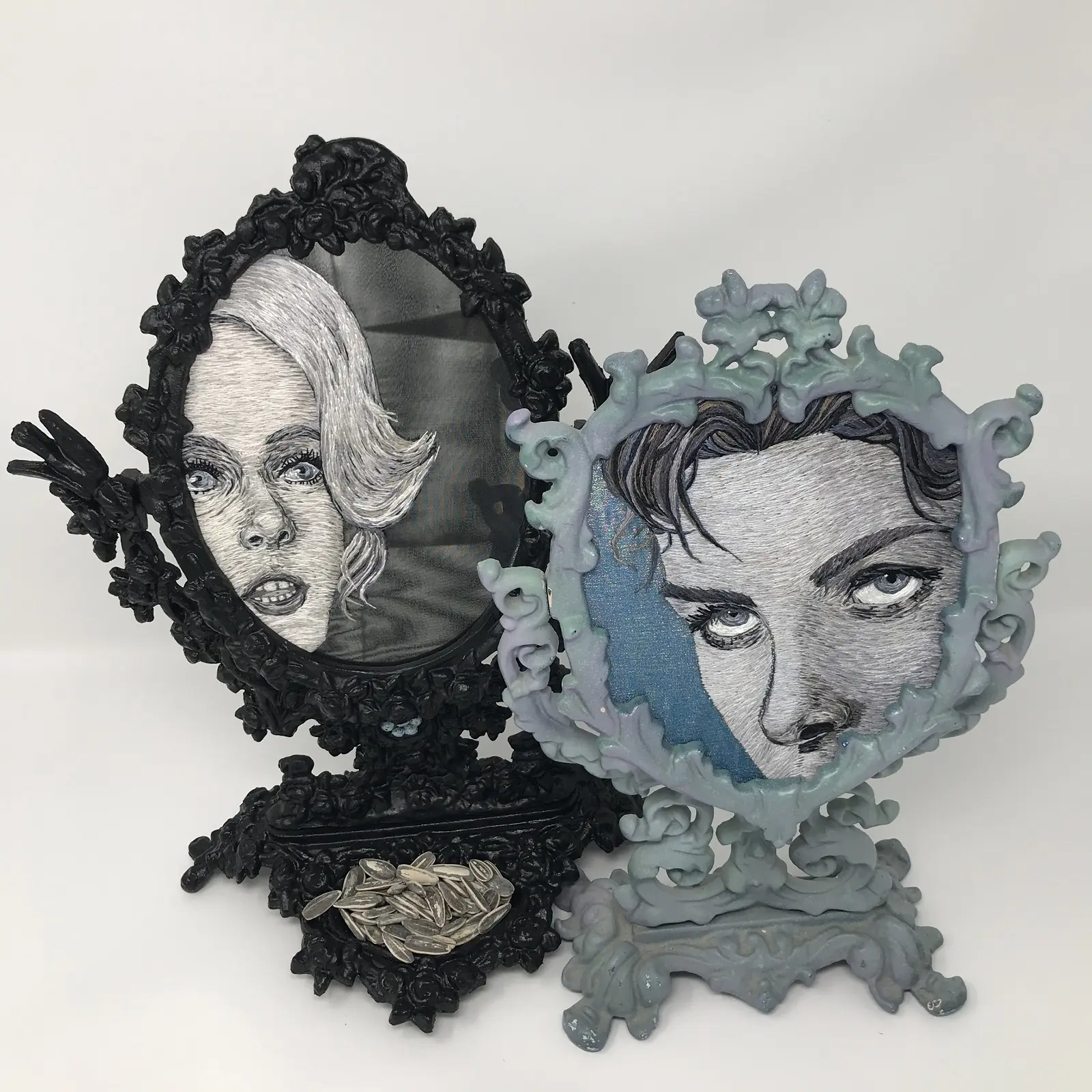
What currently inspires you?
Currently, I am working on a series of portraits embroidered in silk threads on sheer fabrics which are then mounted on mirrors. I am interested in visually defining a contemporary interpretation of the multiple meanings of the word “Look,” which functions as either a noun (an ‘appearance’ or ‘expressing a particular quality’) or as a verb (‘to gaze at’).
By exploring micro-facial expressions and with the mirror mount juxtaposing the viewer’s own image within the piece, I am using these works to ask viewers to consider both the inward and outward gaze in our age of ubiquitous screens, both as mirror of their individual experience and as an encompassing symbol of popular culture.
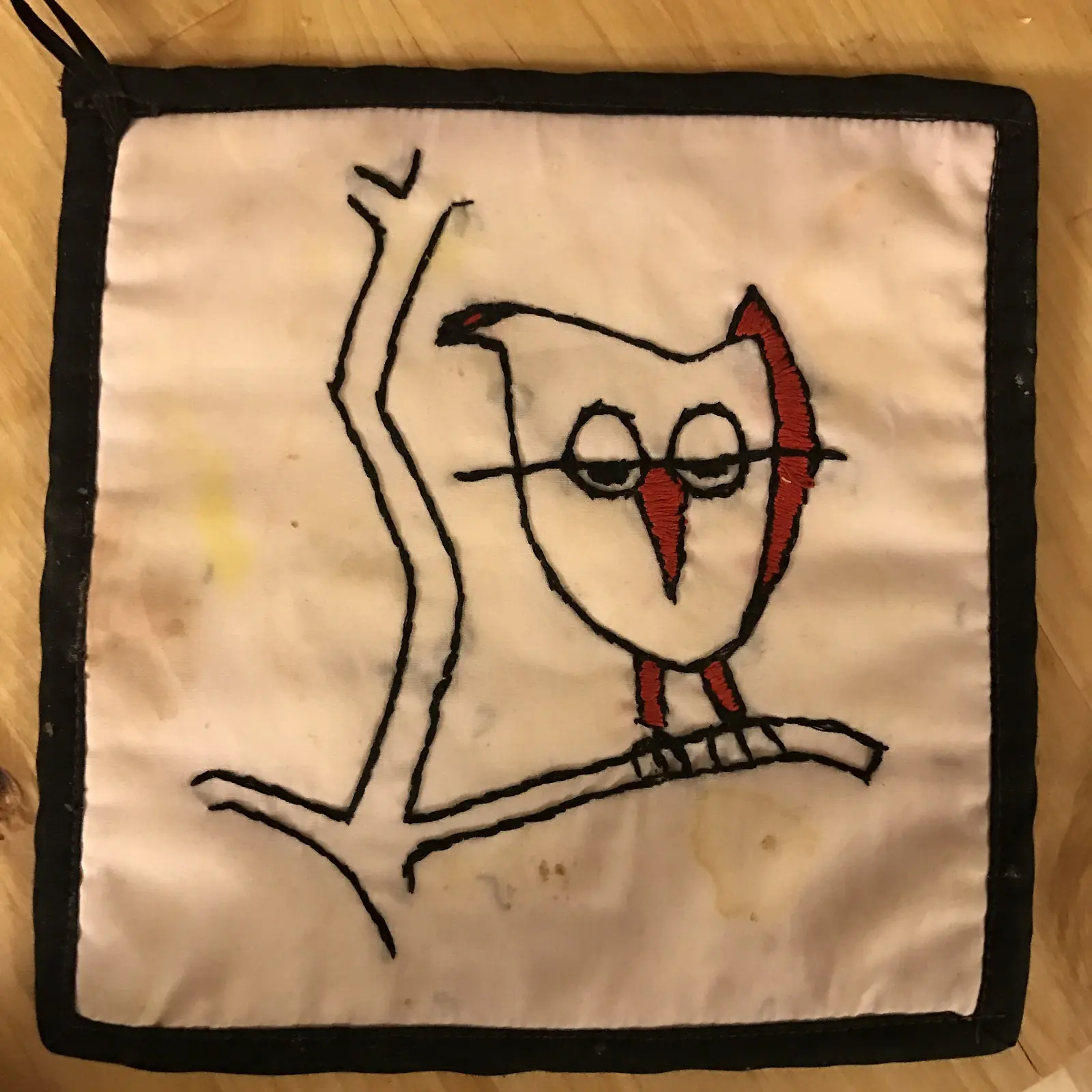
Through the looking glass
Tell us about a piece of your work that holds particularly fond memories and why?
In the late 60’s and early 70’s, my sister and I threw ourselves completely into the embroidered clothing craze when all the cool hippie chicks were adding crewelwork flowers, dogs, fish, feathers and every other groovy motif to overalls, denim shirts, oxford shirts and jeans. My big sister patiently taught me how to get started on an old pink cotton shirt.
I can’t remember why but for my very first embroidery project I made a black outline of a snarky owl on the shirt, filling in parts of the body with red satin-like stitches. That led to a lot of other embroidered clothing over the next few years. Nevertheless, when the fashion for embroidered clothes died out at the end of the ’70s, so did our interest. Needles and hoops were put away and forgotten until that day in my studio when I was so frustrated and choking on pastel dust!
Though it was silly and out of fashion I kept that little owl shirt through all of my childhood moves, through my college days and beyond, holding it as a talisman of my sisterly bond. Eventually, as the shirt began to disintegrate I cut the owl out and made it into a potholder. I kept it in the drawer by the stove, using it to pull hot pies and cakes from the oven and to grab pot handles when the pasta needed a stir.
After I started embroidering as an artist I remembered my little owl and went looking for him at the bottom of the kitchen drawer. He wasn’t there. I felt very sad but I figured he had been lost or accidentally thrown away. Then a year ago while visiting my older son at his apartment, I opened a drawer to help him with something cooking on the stove. There was my faded little owl embroidered on the shabby pink fabric. That silly little owl, sitting in a drawer in a Cambridge bachelor pad had become a bona fide piece of art, loved and now kept by another.
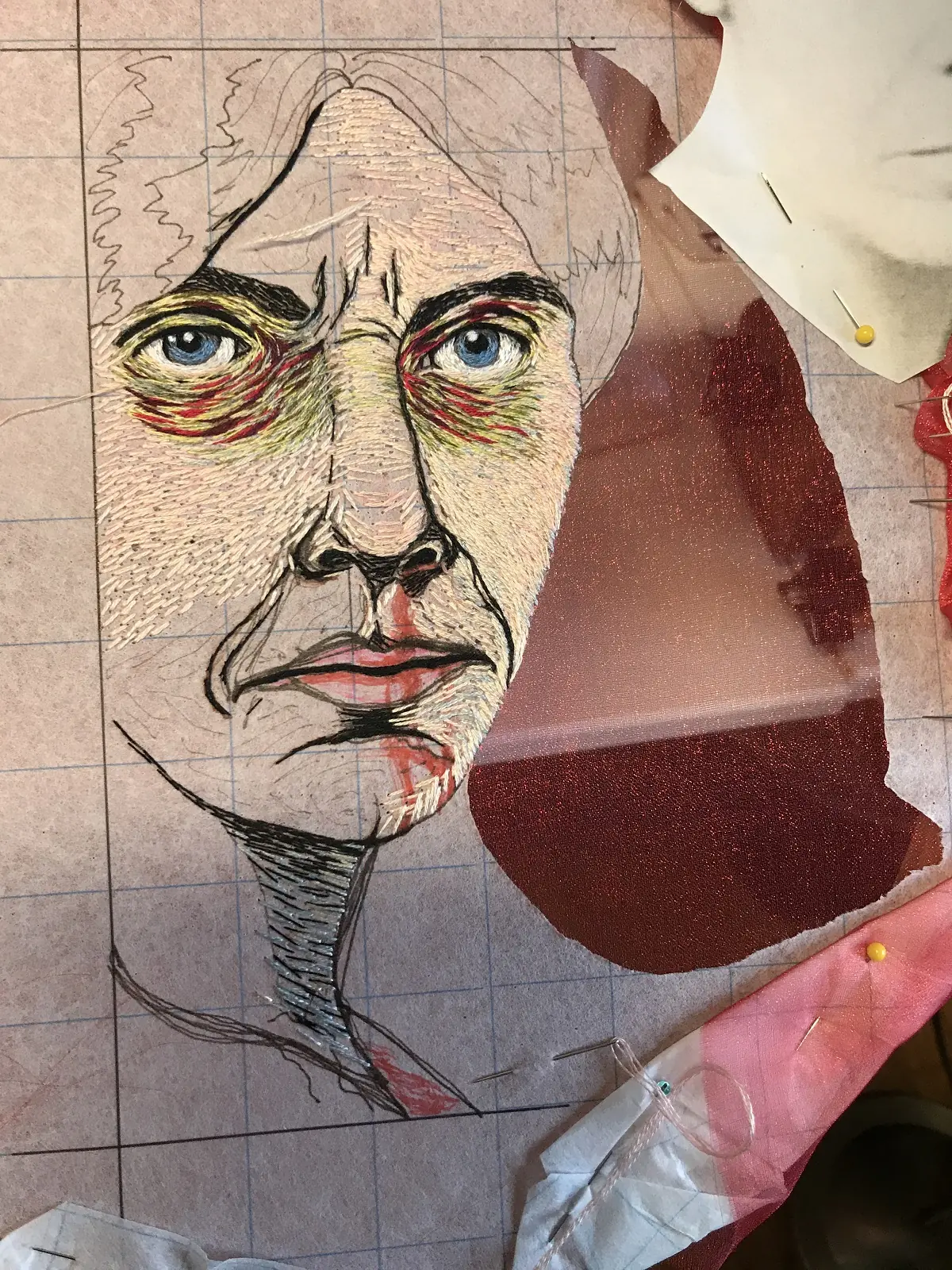
How has your work developed since you began and how do you see it evolving in the future?
For me New Year’s Day is an annual time of self-reckoning. As I think about my work in this coming year, I would like to continue thinking about an aphorism that is nearly as old as the English language: “Thought is the myrrour (mirror) of man, wherein he may beholde (behold) his beauty and his filth…”
I ran across this saying in some rabbit hole I fell into on the internet, just as I was starting to work with mirrors. I think it sums up the ‘Why’ of my mirror project, which I am planning work on for the next year or so.
As an object that reflects our physical appearance and (perhaps) our own inner thoughts, the mirror is something to explore. My job will be to use my needle and thread to conduct a closer examination.
In our self-obsessed age, how have the mirrors of our inner and outer self-reflections evolved and how will they continue to evolve? Do we look into different mirrors on different days, depending upon how carefully or carelessly we manage our visages? What is this idea of ‘looking’ all about in the 2020’s?
Our culture is becoming ever more visual with the explosion of streaming services, virtual reality, 24/7 screen time and image-based social media platforms like Instagram and TikTok. In today’s world, what does it mean to be looked at? What does it mean if no one looks? What does it mean when you present oneself in such a way as to invite or evade such scrutiny?
In these ‘looking at’ and ‘being looked at’ scenarios, who is participating and who is passive? What does it mean to be the one doing the looking? Are there social rules in place, and who, exactly, is setting or enforcing them? If someone curates their appearance to appeal or repel with their ‘look’ are they inviting others to look at them, or to look away with no consequences? Can any act of looking have an exclusively neutral outcome?
I believe that these are questions ripe for artistic rumination and my plan is to spend 2020 and perhaps longer meditating on these ideas with every stitch.
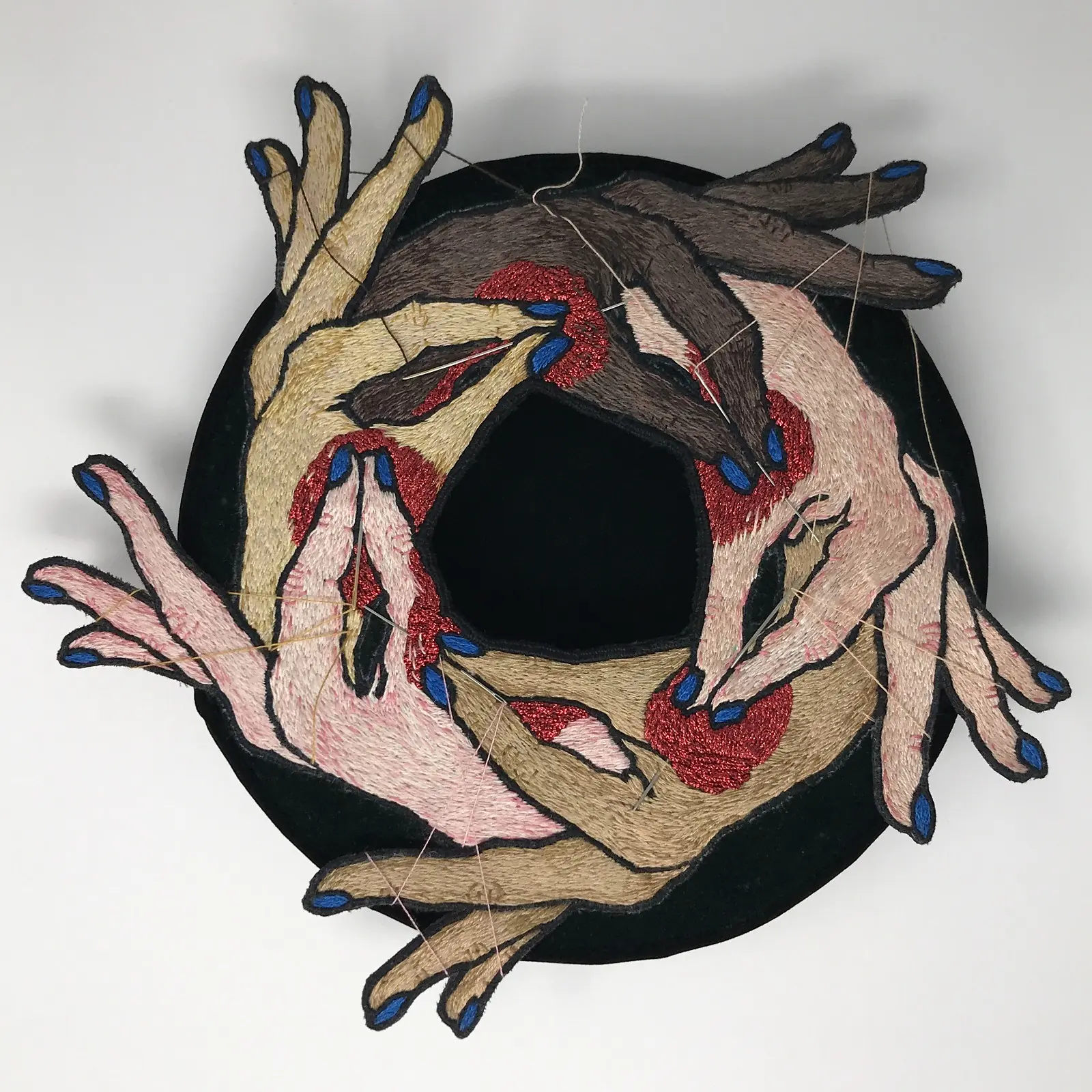
What advice would you give to an aspiring textile artist?
The advice that I would give to any aspiring textile artist is to remember that not only do you make work with textiles, but you are also an artist.
Stitch, weave, dye and fabricate with intent and purpose. On the days when you’re feeling particularly curious, take yourself to a museum or gallery to observe and think about all the artwork that interests you, textile-based or otherwise. Find artists you like. Remember that each of them became artists by bravely claiming the title acting on it. In the past, those working in textiles, mainly women, weren’t allowed in the ‘Fine Art’ club. That will change when we, as textile artists, start demanding an evolution and undeniable elevation with our bold and culturally relevant work.
Make art every day. Like brushing your teeth!
For more information visit catherinehicksart.com
Did you find Catherine’s story inspiring? Let us know by leaving a comment using the buttons below.
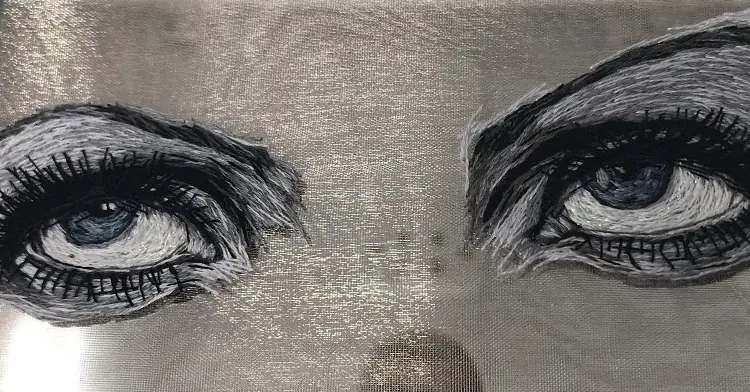

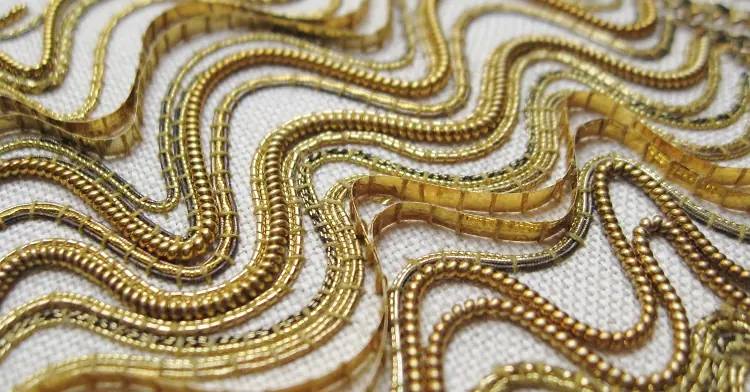
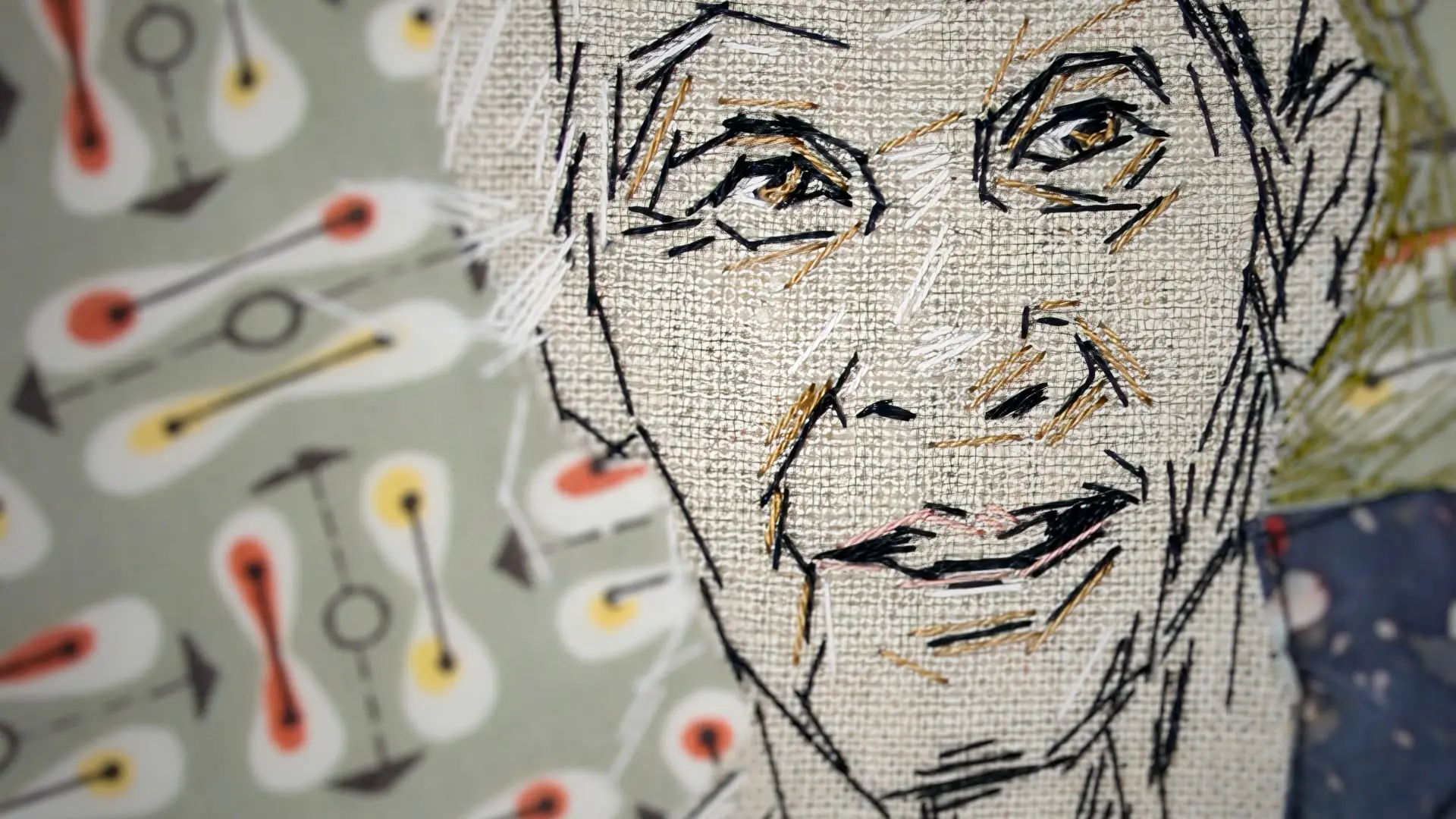
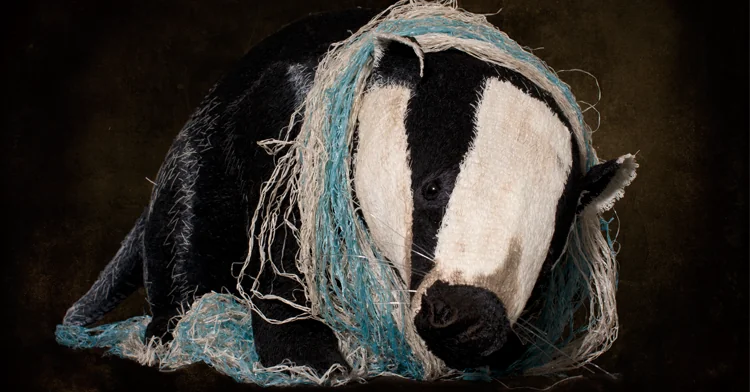
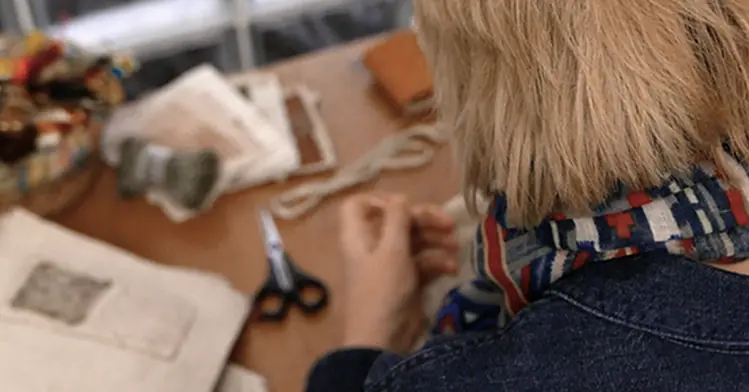
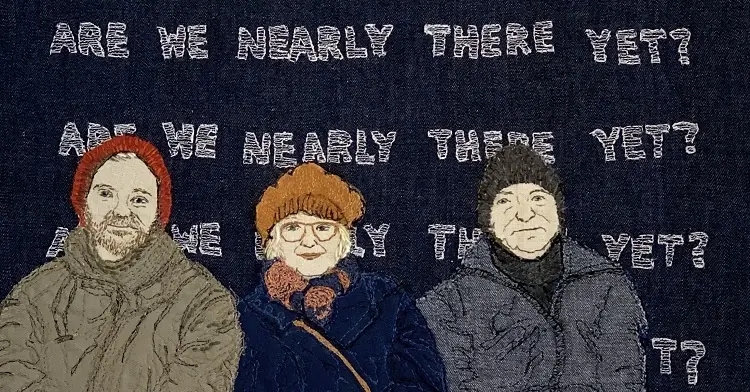
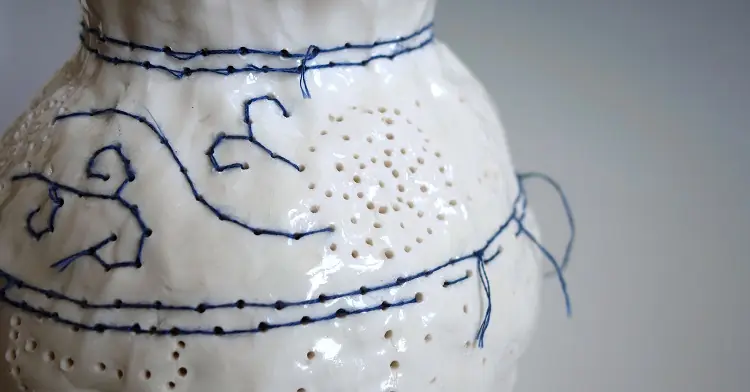
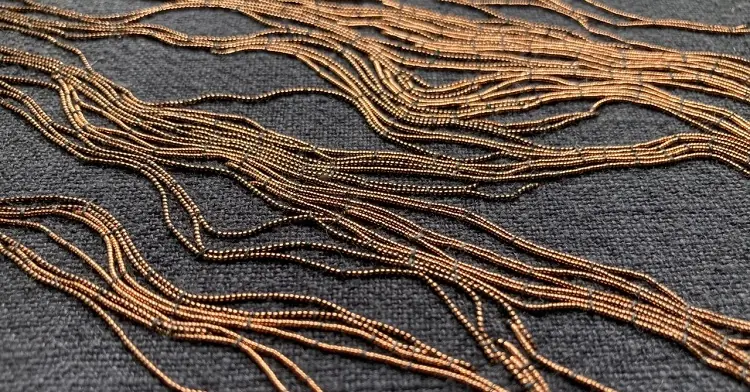
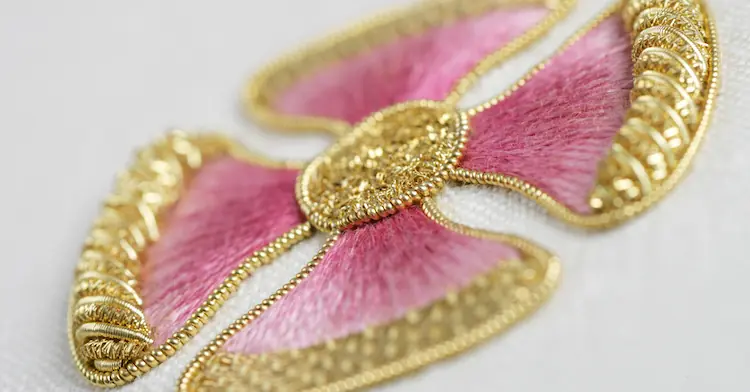
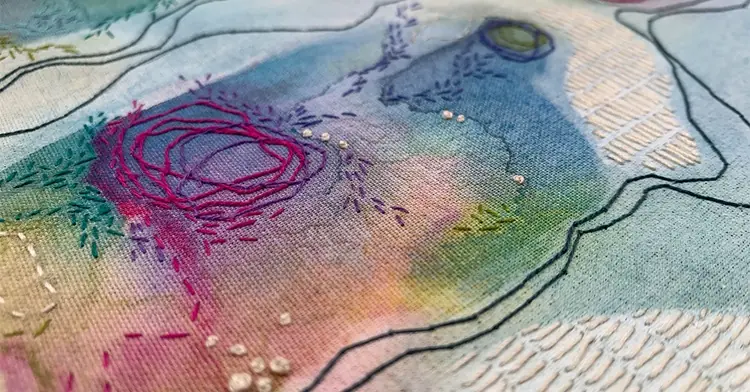
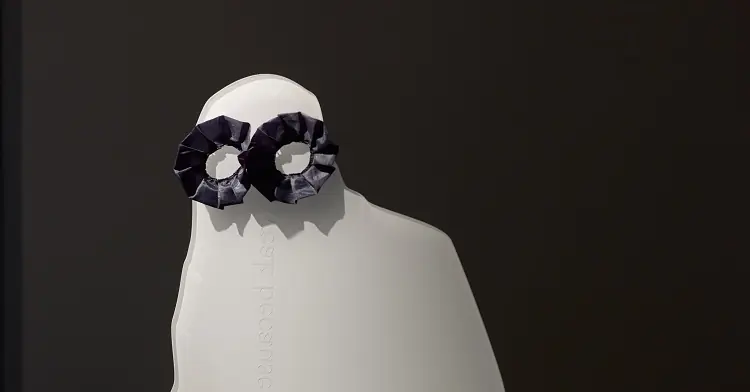
17 comments
Philomena
Catherine, I found your story inspirational, informative and accessible.
Thank you.
Cheryl
Catherine, I am so moved and inspired by your work and your story. Thank you
Alison
You have inspired me to pick up my needle and thread and fabric again! Thank you
Catherine Hicks
To paraphrase Matisse: try to take your needle for a walk each day!
Catherine
Alison
Very encouraging to a fellow stitch artist!!! Thank you for sharing your art!
Catherine Hicks
Thank you, Alison, and thanks to @textileart.org for creating this platform where so many of us can connect and get to know each other! Happy stitching! ❤️
Catherine Hicks
Sorry – I was autocorrected out of @textileartist.org!
Marilyn Clulow
Thank you Catherine for sharing your journey. I so admire your tenacity and absolute perseverance throughout your art life.I wish i had a tiny bit of your self discipline. I have found the piece on you the most inspirational so far. Thank you again.
Catherine Hicks
Dear Marilyn,
Thank you for your kind words! I never used to feel like I had much self discipline at all – the epiphany for me was setting up dedicated studio space (that I didn’t have to clean up or put away) and being a wee bit selfish about my time – primarily through the realization that dishes (laundry, sweeping etc.) can wait. I’m glad that my story was inspirational, and please know that all of you have inspired me right back! Thank you again!
Catherine
A Sanders
Wonderful to read about your journey and your thoughts about creativity. I thoroughly enjoyed it all and am now reading through your blog.
I live in a small village so a bit tricky to do art classes and art history. Did you do art history via an on line class or could you study locally?
Catherine Hicks
Hello, A Sanders,
Thank you for reaching out, and thank you for reading my blog; I hope you enjoy it! I do offer online classes customized to whatever my students want to learn about – please contact me through the portal in my website if you are interested in more information on this. I understand the challenges of living in a small village (my town’s population is 5000) but am so grateful to live in the internet age! Thank you again for your comment!
Catherine
sabrina
Wow these eyes are so expressive! So beautiful embroidery! Compliments!
Catherine Hicks
Sabrina, thanks so much! Although you can’t see it in the photo, I was delighted to realize on this piece that the mirror actually reflects your eyes looking at Garbo’s eyes through the sheer fabric. At first unnerving, it now reads as creepily interesting… thank you for your nice comments!
Catherine
Eve Clark
I am so inspired by Catherine Hick’s story and progression through doing textile art portraits .
Catherine Hicks
Eve,
Thank you so much for your kind words; I set out only to inspire myself, but am lifted to the greatest heights when I hear that others have been moved by my story. Thank you for inspiring me back!
Catherine
Gloria Hansen
Thoroughly enjoyed! Brava!
Catherine Hicks
Thank you, Gloria –
Although neither of us knew it, may have crossed paths at the quilt show in Houston! I enjoyed looking at your page, and thank you for your kind comment – Catherine